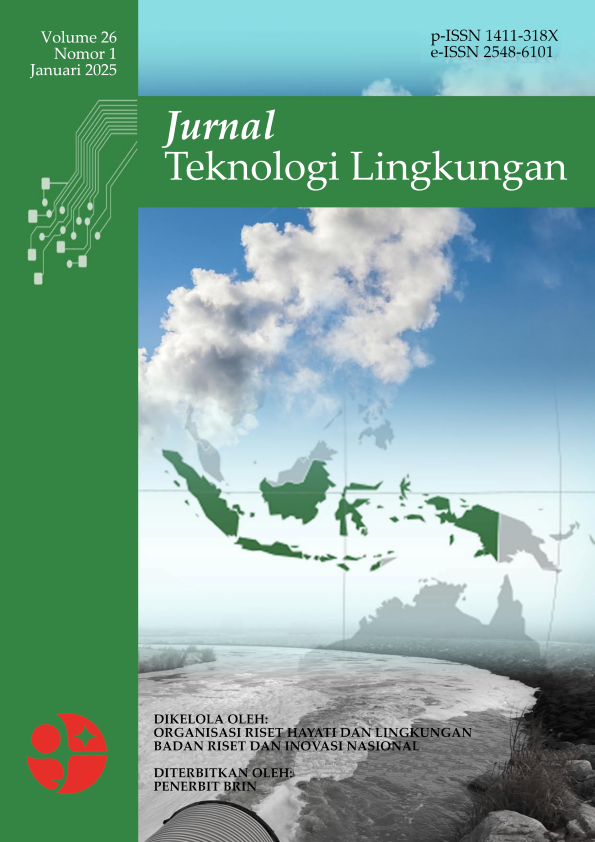Lab Scale Investigation of Inline Powdered Active Carbon-Ultrafiltration Membrane as Pretreatment for Seawater Reverse Osmosis
Main Article Content
Abstract
Reverse osmosis is a technology to that treat treats seawater as an alternative source for of drinking water supply. Several studies confirmed that pretreatment stages, designed to tackle high salinity and organic material in seawater, contribute significantly to the reliability of SWRO technology. Despite its effectiveness, declination of the performance of SWRO after several operation times resulted in potential improvement. Enhancement of pretreatment process to increase the performance of SWRO is necessary to be investigated. A combination of powdered activated carbon and ultrafiltration (PAC/UF) is employed at a lab scale experiment using real seawater matrix collected from an outlet dissolved air flotation unit as SWRO pretreatment stage. The Experiment was conducted employing a polyethersulfone (PES) membrane with an average pore size of 30 nm at dead-end operation with constant flux of 60 and 120 L/m²·h, respectively. For activated carbon, commercial coconut shell-based PAC was added inside the membrane holder and directly deposited on top of the membrane surface. The experiment was conducted by comparing a single filtration cycle operation using UF with/without activated carbon. UF membrane filtration performance, as well as membrane retention, was observed. PAC/UF resulted in higher removal of organic concentration (UV-Vis) (93-96%) compared to UF (14-43%). Both experiments resulted in high removal up to >90% for turbidity and chemical oxygen demand. Nevertheless, insignificant removal of salts concentration (<5%) was observed. In terms of performance, combined PAC/UF revealed better performance despite a thicker layer in comparison to UF membrane at a similar filtered specific volume of water production. Therefore, a combination PAC/UF at constant flux operation was found to be promising and reliable pretreatment for SWRO.
Abstrak
Kebutuhan air minum mengalami peningkatan seiring bertambahnya penduduk, tetapi sumber air bersih mengalami penurunan. Hal ini berdampak terhadap pemanfaatan sumber alternatif air laut untuk pemenuhan kebutuhan air minum dengan teknologi reverse osmosis. Walaupun dapat diandalkan untuk mengurangi salinitas tinggi dan kandungan organik air laut, unit pengolahan seawater reverse osmosis (SWRO) mengalami penurunan kinerja setelah pengoperasian dalam kurun waktu tertentu. Salah satu upaya adalah dengan peningkatan proses prapengolahan untuk SWRO. Pada penelitian ini, kombinasi Karbon Aktif Serbuk dan Ultrafiltrasi mempergunakan air laut yang berasal dari outlet unit prapengolahan pada instalasi SWRO. Percobaan filtrasi dilakukan pada percobaan skala laboratorium mempergunakan membran polyethersulfone (PES) dengan ukuran pori 30 nm pada proses dead-end dengan fluks konstan 60 dan 120 L/m²·jam. Karbon aktif bubuk komersial berbahan dasar tempurung kelapa diletakan di atas permukaan membran. Percobaan dilakukan dengan membandingkan operasi siklus filtrasi tunggal menggunakan UF dengan dan tanpa karbon aktif. Parameter pemantauan kualitas air seperti kandungan organik yang dipergunakan antara lain UV-Vis, kekeruhan, kandungan oksigen kimiawi (COD), dan koduktivitas. Penelitian ini menjelaskan bahwa retensi membran PAC/UF menghasilkan penyisihan konsentrasi organik (UV-Vis) yang lebih tinggi (93-96%) dibandingkan dengan hanya mempergunakan UF (14-43%). Untuk kekeruhan dan kebutuhan oksigen kimiawi, kedua percobaan menghasilkan penyisihan yang tinggi hingga >90%. Jika mengacu pada performa filtrasi membran, volume produksi air yang dihasilkan sebanding untuk percobaan hanya dengan UF dan PAC/UF meskipun lapisan PAC/UF lebih tebal. Berdasarkan temuan pada penelitian ini, dapat disimpulkan bahwa kombinasi PAC/UF pada operasi fluks konstan dapat dipergunakan prapengolahan yang dapat diandalkan untuk SWRO.
Article Details

This work is licensed under a Creative Commons Attribution-ShareAlike 4.0 International License.

